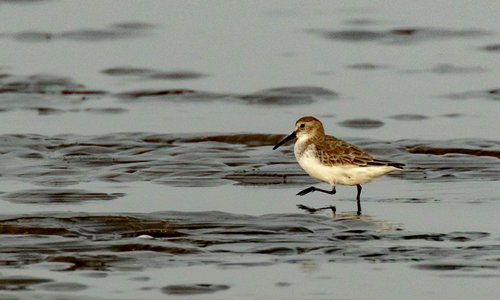HOME >> ARTS
Migratory bird sanctuaries in East China attract global attention
By Bi Mengying Source:Global Times Published: 2019/11/3 17:23:39

Slaty-backed gulls search for food at the migratory bird sanctuaries in Yancheng, East China's Jiangsu Province, on Thursday. Photo: Li Hao/GT

Heron at the migratory bird sanctuaries in Yancheng, East China's Jiangsu Province, on Thursday Photo: Li Hao/GT

Slaty-backed gull at the migratory bird sanctuaries in Yancheng, East China's Jiangsu Province, on Thursday Photo: Li Hao/GT

Kentish plovers at the migratory bird sanctuaries in Yancheng, East China's Jiangsu Province, on Thursday Photo: Li Hao/GT

A dulin at the migratory bird sanctuaries in Yancheng, East China's Jiangsu Province, on Thursday Photo: Li Hao/GT
Known for its spatulate bill and its red-brown head, the spoon-billed sandpiper is a critically endangered bird species. The number of mature individuals is estimated to be between 240 and 456 across the entire globe, according to the International Union for Conservation of Nature (IUCN) Red List website. Now some of these valuable guests, flying in from Russia, are stopping over in the wetlands of East China before continuing their journey south.
Located in Yancheng, Jiangsu Province, the Migratory Bird Sanctuaries along the Coast of the Yellow Sea-Bohai Gulf of China (Phase I) were inscribed on the UNESCO World Heritage List as a natural site in July.
Along with the spoon-billed sandpiper, millions of birds migrating along the East Asian-Australasian Flyway (EAAF) stop by this irreplaceable hub every year for supplies and to molt. The flyway is the most threatened migratory flyway worldwide and involves the largest number of endangered and critically endangered species.
Thanks to its significantly high biodiversity, with about 280 species of fishes and more than 500 species of invertebrates, the sanctuaries are able to provide a great variety of food resources to these migratory birds.
Global significance
The EAAF is one of nine major migratory routes recognized globally. Stretching from Russia and Alaska southwards through East Asia and Southeast Asia to Australia and New Zealand, the flyway encompasses 22 countries.
Situated in the largest intertidal wetland system in the world, the sanctuaries in East China are a central node along the flyway. The entire area of the sanctuaries consists of 16 nominated components, with Phase I accounting for 42 percent at 186,400 hectares. The nomination documents for Phase II, aka the remaining components, will be submitted before February 1, 2022.
"It is the first coastal wetland natural heritage site in China, and the second intertidal natural heritage site in the world," Wu Qijiang, director of the office in charge of the nomination of the sanctuaries, told the Global Times.
Unlike Jiuzhaigou Valley Scenic and Historic Interest Area in Southwest China, which was added to the UNESCO World Heritage List in 1992 for its superb and rare landscapes, the Migratory Bird Sanctuaries are not an independent natural site. Instead, the sanctuaries are one link in a chain that involves many other countries, explained Wu.
In this chain of migration, birds rely on a system of highly productive wetlands to rest and feed, building up sufficient energy to fuel the next phase of their journey.
"Each link in the chain matters," said Wu.
"Among the many natural heritage sites in China, there isn't one that connects more than 20 countries together or has received as much global attention as the sanctuaries."
Moving forward
The number of visitors to the wetland has seen a sharp increase since its inscription on the UNESCO World Heritage List, according to Wang Weiguo, an official for the sanctuaries.
"During the Labor Day holiday [May 1], the number of visitors reached more than 50,000. Yet for the National Day holiday in October, that number rose above 100,000," Wang said.
To ensure that migratory birds are remain undisturbed by tourism, local authorities are considering setting restrictions for public areas.
In addition to real-time 24-hour surveillance, different departments of the government and organizations such as police and urban management officers are stepping up efforts to patrol the region to prevent any behaviors that may hurt the migratory birds.
"While being inscribed on the World Heritage list may boost the cultural confidence of a country, natural sites reveal the concept of development of a country and how the country addresses the relationship between humans and nature," said Wu.
Wu noted that the sanctuaries' successful application to UNESCO was the result of international cooperation. The city of Yancheng looks forward to more cooperation and further exchanges based on the bond of friendship concerning protection of the migratory birds and efforts to improve environmental protection.
To this end, the city has already hosted several international forums and invited experts on wetlands and migratory birds from both China and abroad to exchange notes.
"We are hoping this platform can continue developing. It is also a great opportunity for exchanges between cities across the world, and hopefully it will lead to exchanges and cooperation beyond ecology, extending to the economy, society and humanities," Wu concluded.
Newspaper headline: A link in the chain
Posted in: CULTURE & LEISURE